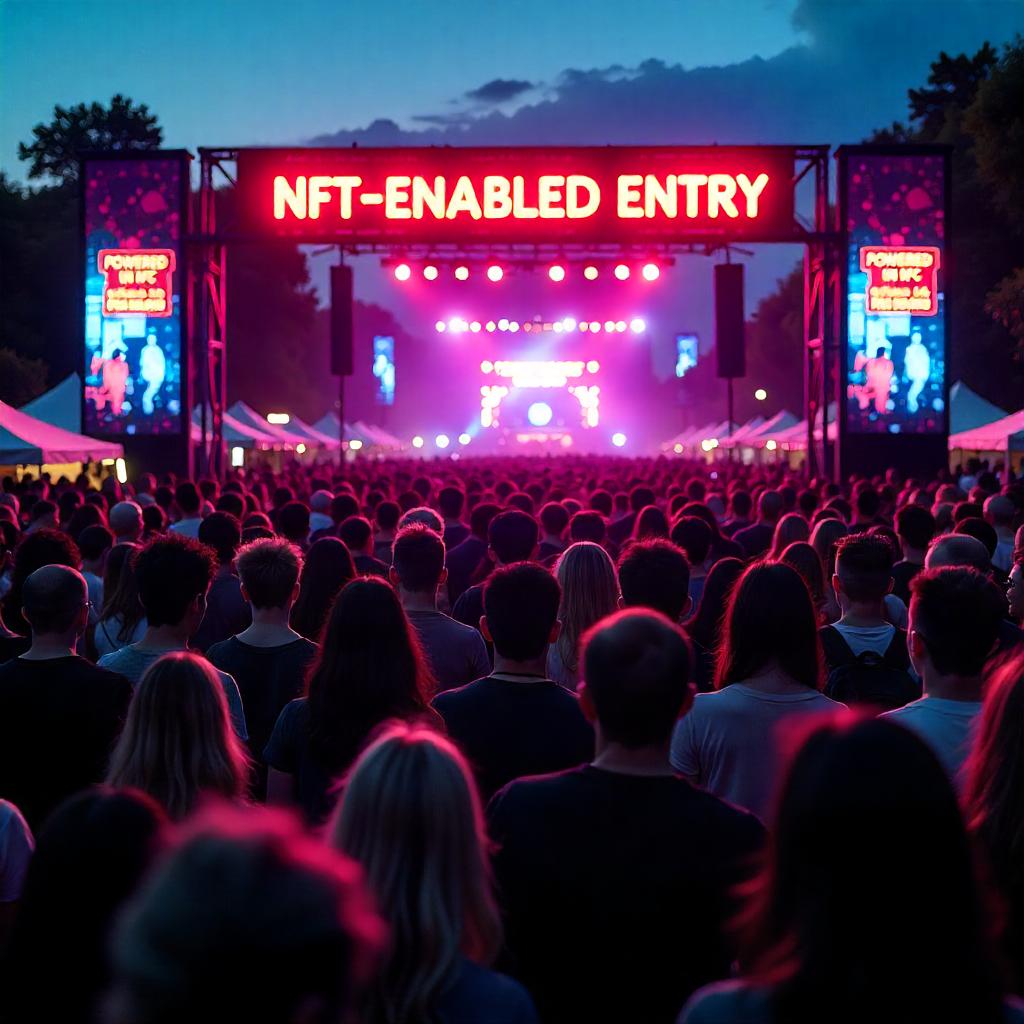NFC ticketing once promised a seamless future where event entry became as simple as tapping a wristband or smartphone—a world where NFT-powered tickets would eliminate scalping, authenticate ownership, and add value for fans and organizers alike. The concept was compelling: a blockchain-backed ticket stored on a contactless chip, offering living proof of attendance, automated royalties, and instant resale under controlled conditions. Yet despite its potential, that promise largely fizzled. Mainstream events were slowed by clunky UX, complex mobile wallets, and slow check-ins—systems built for crypto-savvy users, not concertgoers lining up for Katy Perry or conference attendees hustling for seats.
Enter NFC Release 15. In June 2025, the NFC Forum quietly transformed the landscape with a major technical leap: quadrupling the operational range of NFC chip reads from roughly 0.5 cm to a more forgiving 2 cm. That extended range means users no longer need a surgeon’s precision to tap effectively. It allows phones, wearables, and even rings to initiate contact more reliably—opening the doorway to faster, more intuitive check-ins.
This matters for NFT ticketing because it can bridge usability gaps without sacrificing blockchain security. Imagine pre-minted NFT tickets embedded into NFC wristbands or badges, scanned effortlessly at entry gates—even amidst the chaos of a festival crowd. The blunder of waiting for wallet apps to load or align scans precisely with readers would vanish.
Today, event organizers face a rare convergence: blockchain’s promise matched with hardware that meets the real-world demands of crowds, speed, and familiarity. NFC Release 15 doesn’t just fix one technical detail—it revives the possibility that NFT ticketing can move from crypto experiment to event-day staple.
Why NFT Ticketing Flopped
The dream of NFT tickets once seemed bulletproof: immutable ownership, built-in resale royalties, and blockchain-backed fraud resistance. But when the novelty met reality, user adoption cratered. NFT tickets were heralded as a gateway to eliminating scalpers and counterfeits. In fact, the live events industry loses over $1 billion annually to ticket fraud. Despite this clear pain point, the execution stumbled almost immediately.
First, the user experience was clunky. To access a ticket, fans often had to install a crypto wallet, manage private keys, and understand blockchain networks—barriers for anyone not already crypto-savvy. Many users simply didn’t have compatible wallets. Add to that blockchain network congestion and high gas fees, which spiked during high-profile drops. Transaction fees and delays remain a top obstacle to mass NFT adoption.
Second, credibility cracks appeared in flagship projects. Coachella’s “Keys Collection,” which included ten lifetime festival passes, was tied to the now-bankrupt FTX exchange. When FTX collapsed, holders couldn’t access their NFTs. Even those who managed to withdraw their assets found they no longer functioned as tickets. That highly public failure shook confidence in NFT utility for events.
Third was network limitations under pressure. At scale, blockchains faltered. Purchases failed mid-transaction, resale smart contracts didn’t refresh fast enough, and bot-led mass buys overwhelmed systems.
Lastly, alternatives surged. Facial recognition, mobile payments, and QR codes provided equal or better speed and security without requiring new wallets or education. Some ticketing startups even pivoted from blockchain to biometric check-ins because it offered smoother experiences.
In sum, NFT ticketing stumbled on three fronts: an unwelcoming UX for mainstream users, blockchain infrastructure breakdowns during demand spikes, and landmark project failures that eroded trust. Until those three were fixed, the promise of fraud-resistant blockchain tickets remained just that—promise.
Introducing NFC Release 15: What’s New?
The shortcomings of NFT-powered ticketing systems have been real and well-documented: clumsy check-ins, wallet confusion, failed transactions, and public trust collapses. NFC Release 15 transforms this fragile setup by solving those exact issues.
At its core, Release 15 extends contactless range from a cramped 0.5 cm to a more generous 2 cm—a fourfold increase in operating distance. That length may sound small, but in real-world event environments, it makes all the difference. No longer must fans fumble to precisely align their devices; a wrist flick or a glance-and-tap suffices. That means entry lines move faster, pressure points are reduced, and stress for attendees—and staff—drops dramatically.
Connectivity occurs sooner and more reliably. Instead of struggling to get a wallet app ready and a QR code aligned, tapping an NFC wristband engages instantly. The technology speeds past loading screens or blockchain confirmations at the gate, delivering immediate validation. It’s hardware simplicity backed by blockchain security, but without making every user an accidental crypto developer.
NFC Release 15 also supports smartphones, watches, rings, keycards and badges. Organizers needn’t reinvent their infrastructure; they can leverage devices fans already use. The update paves the way for broader use cases, from mobile payment terminals to digital key access. Event organizers can tap into that ecosystem without requiring each attendee to install wallet software or understand NFTs.
Most critically, the speed and forgiveness of this update quell the worst pain points of blockchain check-in systems. Authentication can happen offline through the NFC chip, with blockchain syncing later. Validation becomes a swift tap-response interaction, invisible to the attendee but recorded immutably behind the scenes.
Combining NFC and Blockchain: A Game-Changer for Event Ticketing
Imagine attendees entering a concert or conference by simply tapping an NFC-enabled wristband or card—instantly verified as a valid ticket, without loading apps or aligning precisely. That’s the future NFC Release 15 unlocks when combined with blockchain-based tokens.
NFC Release 15 layers speed and convenience onto NFT ownership. Organizers can issue pre-minted NFT tickets embedded directly into NFC chips—sealed in wearable wristbands or badges. Each token contains a unique ID and smart contract logic, but attendees don’t need to interact with a wallet or blockchain. They tap at the gate; the NFC reader reads the embedded NFT, verifies it against a secure backend database, and grants access—all in a fraction of a second.
This frictionless model solves the UX problems that plagued early NFT ticketing. With the new 2 cm range, users don’t have to align perfectly or fumble with phones. Instead, an effortless “one-tap” interaction becomes a natural part of the entry process.
Also pivotal is NFC’s offline validation capability. Priority at mass events should not be real-time blockchain confirmation; it’s fast entry. NFC chips equipped with signed tokens can verify authenticity locally. Later, the system syncs data to the blockchain for ledger entry—eliminating queue bottlenecks and blockchain gas spikes.
Festival and stadium trials have already tested this hybrid model. Attendees have used NFC wristbands to gain access and unlock digital experiences without ever needing to understand or even see the blockchain infrastructure behind the scenes. The result is a blend of modern tech with familiar real-world comfort.
Security, Fraud Prevention & Anti-Scalping with NFC
Security is the battleground where ticketing systems win—or lose—trust. Traditional ticket types—paper, QR, even early NFT models—could be counterfeited, resold beyond face value, or copied and duplicated. NFC Release 15 cuts to the heart of these issues by combining cryptographic hardware with seamless user experience.
Each NFC token can embed unique identifiers signed by the issuing smart contract. These are tamper-resistant, unlike paper or screen-generated codes that can be screenshot or duplicated. A wristband or card isn’t just static; it’s a secure hardware asset with unique cryptography locked in. When tapped, the reader verifies the signature instantly, confirming authenticity without reaching back to the blockchain.
Scalping and secondary market control was the flagship promise of NFT ticketing. NFC significantly strengthens this promise. Smart tickets can be encoded with dynamic restrictions—time windows, geography, even holder identity. If a ticket is resold outside approved conditions, NFC readers simply refuse to validate it.
Offline validation is another key advantage. Blockchain congestion has bitten NFT events before—network delays hold up entry lines, generating fan frustration. NFC chips can carry signed validation data allowing them to be checked offline. Afterward, batch synchronization with the blockchain ledger captures attendance records and enforces smart contract rules. This hybrid model keeps the speed high and the integrity intact.
What Event Organizers Must Consider
When NFC Release 15 and blockchain-powered NFT tickets converge, the promise is transformative—but execution matters. For event organizers to make this win, multiple moving parts must align: infrastructure readiness, platform partnerships, and strategic planning.
Hardware readiness is non-negotiable. NFC readers and gates must support Release 15 to unlock the extended read range and reduced alignment error. That means upgrading devices or partnering with providers who have devices built for Release 15, which is expected to be widely available by late 2025.
Ticketing platforms must support hybrid authentication—where wristband-embedded tokens are securely verified offline at scale, and later synced on-chain. Blockchain-backed ticketing systems that have already implemented secure, resale-conditioned access demonstrate the importance of back-end integration and identity-based controls.
Organizers must also choose the right blockchain layer. High gas fees or congestion cripple event-day flow. Layer 2 solutions offer speed and low cost while maintaining auditability.
Hardware partnerships are crucial. Brands like NXP, Sony, and Infineon are rolling out their Release 15 chips now. Partnering with them and early-compliant smartphone or wearable providers ensures compatibility from day one.
User onboarding should never be an afterthought. Fans should receive NFC wristbands pre-loaded with tickets, simple instructions, and real-time support at events. When onboarding is smooth, adoption becomes easy—even for audiences previously skeptical of blockchain.
Revenue Opportunities & Business Models
NFC-enabled NFT tickets aren’t just a technical novelty—they open entirely new revenue pathways for event organizers. By embedding smart ticketing into everyday hardware like wristbands or badges, organizers can generate income well beyond the door price.
Resale royalties can become a predictable revenue stream. When NFC tickets are linked to blockchain smart contracts, organizers can enforce royalty percentages on every secondary sale. Some events have generated significant income through controlled resales, with transparency and trust intact.
Post-event engagement becomes monetizable. NFC wristbands can unlock exclusive NFT drops—backstage photos, artist tracks, discount vouchers—that attendees receive automatically after tapping at exit gates. These digital collectibles not only drive fan loyalty but can also be resold or traded, adding ongoing value.
Data-driven sponsorship is another major upside. NFC check-ins at sponsor booths and activation zones generate high-quality engagement analytics, boosting sponsor ROI and making inventory more appealing for future deals.
NFC tickets also enable cashless onsite commerce. Attendees can tap to buy drinks, merchandise, or services. Organizers have reported increased per-head spending when friction is removed.
Future Outlook
The emergence of NFC Release 15 marks more than just a technical upgrade—it signals a sea change across event technology. As chipmakers and platform providers align with this new standard, blockchain-powered NFC ticketing is poised to go mainstream.
By late 2025, certified Release 15 hardware will be widespread across major device ecosystems. Event organizers will begin offering integrated wristband experiences that combine access, payment, loyalty rewards, and exclusive content.
Broader applications will soon follow—from digital keys to proof of presence systems in enterprise and lifestyle settings. Standardization and cross-chain support will ensure that early adopters remain flexible and future-proof.
For event organizers, this evolution is not a matter of if—it’s a matter of when.
Call to Action
If you’re an event organizer, this is your moment to lead.
Start by auditing your current ticketing process. Are your entry systems fast enough? Secure enough? Flexible enough to meet fan expectations in 2025 and beyond?
Now is the time to explore pilot integrations with NFC Release 15-ready devices. Partner with ticketing platforms that offer blockchain compatibility, consult hardware vendors rolling out compliant readers, and consider Layer 2 chains that can power your ticket logic without slowing your gates.
Don’t wait for this shift to become standard. Be the one who sets the standard.
If you want help designing your first NFC-NFT ticketing pilot or connecting with ecosystem partners, subscribe to our insights list. We’re launching a full “Web3 Events Toolkit” next month—packed with vendor recommendations, UX design checklists, smart contract templates, and proven activation strategies.
The future of ticketing is secure, seamless, and smart. And it’s just a tap away.





